Nursery Lamps and Nightlights:
Choosing the Best Color Light
Are Nursery Lamps Necessary?
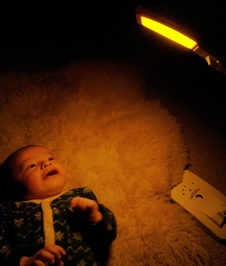 Warm. Dimmable Nursery Lamp
Warm. Dimmable Nursery Lamp
Nursery lamps and nightlights are one of the few truly necessary accessories for new parents. Experts now recommend that newborns be awoken to feed every two to three hours throughout the night during their first few weeks of life. Even after this period, most infants and children will need be changed and comforted regularly throughout the night. Turning on a bright overhead light during each feeding is not only drastically alerting, but can be potentially harmful to the sleep health of both the mother and infant. In contrast, a warm, dimmable nursery lamp or red nursery nightlight can offer just enough light to allow safe, comfortable evening activity for parents without disrupting sleep patterns. However, research finds that even some seemingly dim nursery lamps and night lights can disrupt the sleep of both parent and child. Careful attention must be paid to not only the brightness, but the color of the nursery light as well.
Bright Light, Melatonin, and Sleep
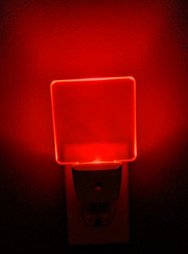 Red Night Lights Protect Melatonin Production
Red Night Lights Protect Melatonin Production
Exposure to room lighting at night blocks production of the sleep hormone melatonin in 99% of adults and children. Melatonin is responsible for helping us fall asleep, stay asleep, and a host of related health and immune functions (see these articles for a more detailed look at melatonin and health and melatonin and cancer). A 2011 study found that, “Compared with dim light, exposure to room light before bedtime suppressed melatonin, resulting in a later melatonin onset in 99.0% of individuals and shortening melatonin duration by about 90 min” (Gooley, et al). While nursery lighting is necessary, particularly in the first months of childhood, the vast majority of parents are using the wrong kind of light.
Blue Light Can Disrupt Infants’ Sleep
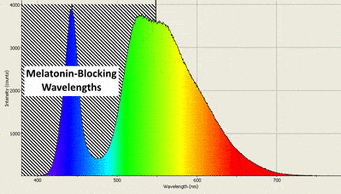 Blue and Green Light Block Melatonin Production
Blue and Green Light Block Melatonin Production
Not all lights are created equal. Short wavelengths of light (blue, green, and white) interact with the melanopsin receptors in our retinas, drastically reducing melatonin production and inhibiting sleep. Our bodies interpret blue and white light as daylight, so even a 5-minute exposure to bright lighting can cause a drastic alerting effect lasting up to 90 minutes (Rimmer, et al). In fact, even very dim blue light (100 lux) has been demonstrated to reduce melatonin production by 50% (Zeitzer, et al). For this reason, most pediatricians and pediatric associations recommend nursery lighting free from blue and green wavelengths. While blue and green may seem like calming, restful colors, parents should resist the urge to use blue, green, or white nightlights or nursery lamps in the evening.
What Colors of Light are Best for the Nursery?
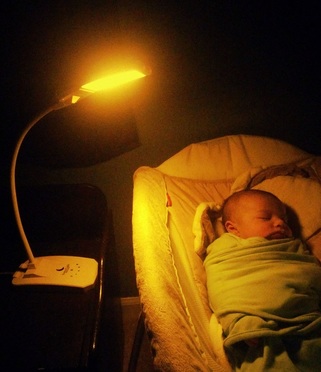 Dimmable Nursery Lamp
Dimmable Nursery Lamp
On the other hand, long wavelengths, like red and amber, have been shown to have no negative effect on sleep and melatonin production. Red and amber light simply does not interact with the melanopsin receptors. In fact, one experiment found that even very bright amber light (800 lux) had almost no effect on melatonin production (Kayumov et al). For this reason, red and amber light acts as virtual darkness, protecting both you and your baby’s melatonin production, sleep, and overall health.
For these reasons, most pediatricians recommends dim, warm light sources for nurseries to help protect mom and baby's melatonin production and to avoid awakening or alerting the baby during nighttime feedings.
Learn more about Melatonin and Sleep, Melatonin and Health, or Melatonin and Cancer.
Purchase an amber sleep light, amber glasses for sleep, red nursery night lights, and dimmable nursery lamps here.
For these reasons, most pediatricians recommends dim, warm light sources for nurseries to help protect mom and baby's melatonin production and to avoid awakening or alerting the baby during nighttime feedings.
Learn more about Melatonin and Sleep, Melatonin and Health, or Melatonin and Cancer.
Purchase an amber sleep light, amber glasses for sleep, red nursery night lights, and dimmable nursery lamps here.
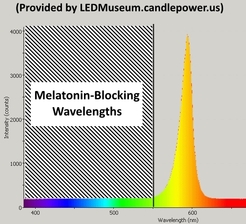 Amber Nursery Lights do not block Melatonin Production
Amber Nursery Lights do not block Melatonin Production
Sources:
Burkhard, K. & Phelps, J.R. (2009). Amber lenses to block blue light and improve sleep: A randomized trial. Chronobiology International, 26 (8), 1602-1612.
Gooley, J. J., Chamberlain, K., Smith, K. A., Khalsa, S. B. S., Rajaratnam, S. M. W., Van Reen, E., … Lockley, S. W. (2011). Exposure to Room Light before Bedtime Suppresses Melatonin Onset and Shortens Melatonin Duration in Humans. The Journal of Clinical Endocrinology and Metabolism, 96(3), E463–E472. doi:10.1210/jc.2010-2098
Jamie M Zeitzer, Derk-Jan Dijk, Richard E Kronauer, Emery N Brown, Charles A Czeisler. J Physiol. Sensitivity of the human circadian pacemaker to nocturnal light: melatonin phase resetting and suppression. 2000 August 1; 526(Pt 3): 695–702. doi: 10.1111/j.1469-7793.2000.00695.x PMCID: PMC2270041.
Burkhard, K. & Phelps, J.R. (2009). Amber lenses to block blue light and improve sleep: A randomized trial. Chronobiology International, 26 (8), 1602-1612.
Gooley, J. J., Chamberlain, K., Smith, K. A., Khalsa, S. B. S., Rajaratnam, S. M. W., Van Reen, E., … Lockley, S. W. (2011). Exposure to Room Light before Bedtime Suppresses Melatonin Onset and Shortens Melatonin Duration in Humans. The Journal of Clinical Endocrinology and Metabolism, 96(3), E463–E472. doi:10.1210/jc.2010-2098
Jamie M Zeitzer, Derk-Jan Dijk, Richard E Kronauer, Emery N Brown, Charles A Czeisler. J Physiol. Sensitivity of the human circadian pacemaker to nocturnal light: melatonin phase resetting and suppression. 2000 August 1; 526(Pt 3): 695–702. doi: 10.1111/j.1469-7793.2000.00695.x PMCID: PMC2270041.
Kayumov L, Casper RF, Hawa RJ, Perelman B, Chung SA, Sokalsky S, Shapiro CM (May 2005). "Blocking low-wavelength light prevents nocturnal melatonin suppression with no adverse effect on performance during simulated shift work". J. Clin. Endocrinol. Metab. 90 (5): 2755–61.
Rimmer DW, Boivin DB, Shanahan TL, Kronauer RE, Duffy JF, Czeisler CA. Dynamic resetting of the human circadian pacemaker by intermittent bright light. Am J Physiol Regul Integr Comp Physiol. 2000 Nov;279(5):R1574-9.
PMID: 11049838
http://parent.guide/how-to-choose-the-best-night-light-for-your-baby/
https://sarahockwell-smith.com/2015/03/19/one-simple-way-to-improve-your-baby-or-child-sleep/
https://www.lowbluelights.com/news_full.asp?id=6
Rimmer DW, Boivin DB, Shanahan TL, Kronauer RE, Duffy JF, Czeisler CA. Dynamic resetting of the human circadian pacemaker by intermittent bright light. Am J Physiol Regul Integr Comp Physiol. 2000 Nov;279(5):R1574-9.
PMID: 11049838
http://parent.guide/how-to-choose-the-best-night-light-for-your-baby/
https://sarahockwell-smith.com/2015/03/19/one-simple-way-to-improve-your-baby-or-child-sleep/
https://www.lowbluelights.com/news_full.asp?id=6